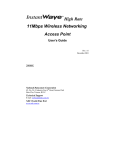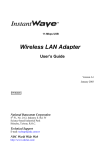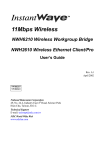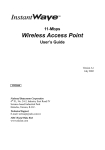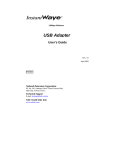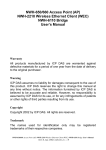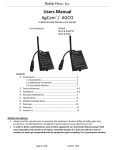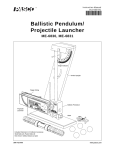Download NDC comm Instant Wave User's Manual
Transcript
High Rate 11Mbps Wireless Networking Access Point User’s Guide Rev.10 DEC 2000 National Datacomm Corporation. 4F, No. 24-2, Industry East 4th Road, Science Park, Hsin-Chu, Taiwan, R.O.C. Tel: 886-3-5783966 Fax: 886-3-5777989 Technical Support E-mail: [email protected] NDC World Wide Web www.ndc.com.tw TRADEMARKS NDC and InstantWave are trademarks of National Datacomm Corporation. All other names mentioned in this document are trademarks/registered trademarks of their respective owners. NDC provides this document “as is”, without warranty of any kind, neither expressed nor implied, including, but not limited to, the particular purpose. NDC may make improvements and/or changes in this manual or in the product(s) and/or the program(s) described in this manual at any time. This document could include technical inaccuracies or typographical errors. FCC WARNING This equipment has been tested and found to comply with the limits for a Class B Digital device, pursuant to part 15 of the FCC Rules. These limits are designed to provide reasonable protection against harmful interference in a residential installation. This equipment generates, uses, and can radiate radio frequency energy and, if not installed and used in accordance with the instructions, may cause harmful interference to radio communications. However, there is no guarantee that interference will not occur in a particular installation. If this equipment does cause harmful interference to radio or television reception, which can be determined by turning the equipment off and on, the user is encouraged to try to correct the interference by one or more of the following measures: Reorient or relocate the receiving antenna Increase the separation between the equipment and receiver Connect the equipment into an outlet on a circuit different from that to which the receiver is connected Consult the dealer or an experienced radio/TV technician for help You are cautioned that changes or modifications not expressly approved by the party responsible for compliance could void your authority to operate the equipment. This device complies with part 15 of the FCC Rules. Operation is subject to the following two conditions: 1. This device may not cause harmful interference, and 2. This device must accept any interference received, including interference that may cause undesired operation ii InstantWave High Rate Access Point Table Of Contents Introduction........................................................................................................................................ 1 INSTANTWAVE HIGH RATE FAMILY ..........................................................1 SYSTEM REQUIREMENTS ..............................................................................1 CABLING ............................................................................................................1 Glossary............................................................................................................................................... 2 How to Use this Guide...................................................................................................................... 3 Planning Your Network................................................................................................................... 4 INFRASTRUCTURE NETWORK TYPES.........................................................4 PLANNING AN INFRASTRUCTURE NETWORK..........................................6 Single AP Installation .......................................................................................6 Multiple AP Installation ....................................................................................6 ROAMING...........................................................................................................7 ACCESS POINT PLACEMENT GUIDELINES.................................................8 Placing For Performance...................................................................................8 Placement Tools ................................................................................................8 MOUNTING THE AP .........................................................................................8 Getting Started................................................................................................................................... 9 ACCESS POINT HARDWARE INSTALLATION ............................................9 LED INDICATORS.............................................................................................9 AP MANAGEMENT SOFTWARE INSTALLATION/UNINSTALLATION .11 Installation.......................................................................................................11 Uninstalling.....................................................................................................11 AP COMFig Tool............................................................................................................................12 USING THE AP COMFIG TOOL.....................................................................12 AP COMFig Password....................................................................................12 AP COMFig Service .......................................................................................13 Perform AP Self Diagnostic Test ....................................................................18 InstantWave High Speed Access Point iii Upgrade AP Firmware ....................................................................................18 Reset AP Configuration ..................................................................................18 Trouble Shooting .............................................................................................................................19 Operational Problems...................................................................................19 Technical Support ...........................................................................................................................21 NDC Limited Warranty................................................................................................................22 Index...................................................................................................................................................26 iv InstantWave High Rate Access Point List of Figures FIGURE 1. SIMPLE WIRELESS INFRASTRUCTURE NETWORK .................... 4 FIGURE 2. AP TO WIRED ETHERNET BRIDGE .......................................... 5 FIGURE 3. MULTIPLE AP NETWORK ....................................................... 5 FIGURE 4. ACCESS POINT ........................................................................ 9 FIGURE 5. ACCESS POINT ........................................................................ 9 FIGURE 6. ACCESS POINT LEDS............................................................ 10 FIGURE 7. LED FUNCTIONS .................................................................. 13 FIGURE 8. AP COMFIG TOOL/SERVICE ................................................ 13 FIGURE 9. CONFIGURATION/GENERAL .................................................. 13 FIGURE 10. ENCRYPTION ........................................................................ 16 FIGURE 11. CONFIGURATION/FILTER .................................................... 117 InstantWave High Speed Access Point v Packing List The package should contain the following items: • One Access Point • One diskette for AP Management Software • One AC Power Adapter • This User’s Guide vi InstantWave High Rate Access Point Introduction Congratulations on choosing one of NDC’s InstantWave High Rate wireless networking product’s family. InstantWave High Rate was one of the first IEEE 802.11b wireless standard compliant products in the industry and was designed to maximize the convenience of networking. You will find InstantWave High Rate products very easy to setup and use. The User’s Guide gives comprehensive instructions on installing and using the InstantWave High Rate Access Point (AP). The AP provides a transparent bridged connection between a wired network and a wireless network and allows your wireless stations to communicate with devices attached to your wired network. It manages the flow of data packets from the wired LAN to the wireless LAN, and vice versa. InstantWave High Rate Family The InstantWave High Rate Access Point is part of a family of easy to use high performance wireless communication products. The family products include: • InstantWave High Rate Access Point (NWH660, NWH650) • InstantWave High Rate PCI Card (NWH630) • InstantWave High Rate PC Card (NWH610) System Requirements System requirements to install and operate the InstantWave High Rate Access Point are: • A RS-232 cable • An Ethernet drop (UTP) • A PC (only used when configuration of the AP’s Network properties is necessary) Cabling Connecting the AP to an Ethernet network requires an Unshielded Twisted-Pair cable. The AP fits into the network just as any other node would do. An LED will light to indicate a connection. The cable length should follow Ethernet standards in each case. InstantWave High Rate Access Point 1 Glossary Group ID/BSSID A Group ID (the 802.11 standard uses the term BSSID) is the ID of a wireless cell. A wireless cell is usually made up of stations in an area that the radio signal can comfortably cover. In other words, any wireless station in the cell can communicate with any other within reach of the radio signal. Domain Name/ESSID A “Domain” is most commonly used to refer to a group of computers whose hostnames share a common suffix. The domain is usually defined by the network administrator as a segment/subnet of a large network and may be made up of overlapping wireless cells. Wireless nodes can roam freely within the same domain without disconnecting from the network. Roaming The convenience of a mobile PC is the ability to move freely. The concept is similar to that of a cellular phone moving from one base station to another. InstantWave High Rate offers built-in high performance and seamless roaming capabilities. Regulatory Domain InstantWave High Rate products use the unlicensed ISM (Industrial, Scientific, Medical) band to communicate through radio waves. Different countries offer different radio frequencies to be used as the ISM band. There are four frequency bands defined by 802.11: Japan (2.471GHz – 2.497 GHz), USA, Extended Japan, Canada, and Europe (2.4 GHz – 2.4835 GHz), Spain (2.445 GHz – 2.475 GHz), and France (2.4465 GHz – 2.4835 GHz). To use InstantWave High Rate in a country not listed above, check with your government’s regulating body to find the correct frequency band to use. All InstantWave High Rate products are supplied preset to the country of sale’s frequency band. 2 InstantWave High Rate Access Point How to Use this Guide InstantWave High Rate is extremely versatile in providing varying levels of network management. For Small Office/Home Office users, setup and configuration is a quick, four-step process. The Access Point Hardware Installation section, on page 9, provides simple instructions to get your network up and running within minutes. Go to the Access Point Hardware Installation section if your network will meet the following criteria: • • You will accept all default values Your network will have only one Access Point The AP COMFig Tool, see page 12, permits AP configuration from a PC via a COM port connection. The program enables the user to change the default Access Point IP configuration settings before introducing a new AP to an already established wireless network. Before using the setup tool, you should read through the next section “Planning Your Network”, in order to get the best possible performance from your InstantWave High Rate wireless network. InstantWave High Rate Access Point 3 Planning Your Network Infrastructure Network Types An Infrastructure network is formed by several stations and one or more Access Points (APs), with the stations within a set distance from the AP. Figure 1 depicts a typical Infrastructure network topology. There are three infrastructure network setups that are commonly used. It is a good idea to understand the possible network setups and configuration requirements before planning your wireless network. Type 1. The simplest wireless infrastructure network is composed of one Access Point (AP) and a few wireless Stations communicating via radio waves (Figure 1). This setup enables mobile stations to communicate with each other. The main benefit of this type of network is to extend the range of the network. If an AP is placed between Station-1 and Station-2, the radio transmission distance is effectively doubled since Station-1 can talk to Station-2 through the AP. The drawback of this configuration is that the effective bandwidth is halved since all communication is relayed by the AP. Figure 1. Simple Wireless Infrastructure Network Type 2. The next simplest wireless network is very similar to the Type 1 network. This time the AP is connected to a wired Ethernet network as a node. In this configuration the AP is effectively performing as a bridge between the wired Ethernet and the wireless networks (Figure 2). Wireless users have the same access to the network resources as they would have if they were wired. This type of network is usually used to extend an existing network into a difficult to wire or a roaming environment. 4 InstantWave High Rate Access Point Server Figure 2. AP to Wired Ethernet Bridge Type 3. The third type of network is composed of multiple APs and multiple Stations (Figure 3). The APs could also be connected to servers on the wired Ethernet network. The shadowed area represents signal overlap between subnet1 (AP-1) and subnet2 (AP-3). Figure 3. Multiple AP Network The reasons for having multiple APs installed are: 1. 2. To increase bandwidth in order to boost overall network performance To extend the coverage range Any other type of configuration is usually a mix of these commonly used types. InstantWave High Rate Access Point 5 Planning an Infrastructure Network This section explains some of the things you need to consider in planning an Infrastructure network. Setting up is a two step process. 1. 2. Install and configure the InstantWave High Rate products Decide the best physical location of the InstantWave High Rate products so as to optimize performance The following sections give quick guidelines for these two steps. Before we go into detail, the network planner should first decide whether to have a single AP wireless network or a multiple APs network. Single AP Installation If you are setting up a simple network with only one AP and a few Stations (a Type 1 or Type 2 network configuration as described in Infrastructure Network, page 4), the installation can be performed painlessly. All you need to do is make sure the AP and all the wireless Stations hold the same “Domain Name” in their configuration. Adding a new Station to an existing Infrastructure Network is easy. Again, all you need to do is to set the newly added Station’s “Domain Name” to the same as that of the AP’s. Multiple AP Installation Install multiple APs in the same network (or Domain) with an overlapping signal (Figure 3) • • Use the same Domain Name Enable the roaming function in the Station if roaming is required Note: A Station will automatically connect to whichever AP in the same domain is offering the best signal 6 InstantWave High Rate Access Point Roaming InstantWave High Rate products are equipped with seamless roaming capabilities. Roaming is necessary to prevent mobile Stations from being disconnected from the network as they move around. InstantWave High Rate is designed to allow wireless Stations to roam freely within an infrastructure domain composed of multiple APs with overlapping signal coverage (as in the Type-3 network configuration described in the previous section). For example, roaming enables Station-1 to move from the AP-1 signal coverage area to the AP-2 signal coverage area without disconnecting from the network. The handover is achieved transparently; the Station-1 user would not realize he had moved from AP-1 to AP-2. The requirements for a roaming environment are: a) Multiple APs with overlapping signal coverage (see Multiple AP Installation, page 6) b) The APs must be configured to have the same Domain name (see AP COMFig Service, page13) c) The mobile Stations must have the same Domain name as that of the APs d) *It is advisable that APs on different TCP/IP subnets be given different Domain names to avoid roaming confusion (seeAP COMFig Service , page13) Note: If you want to move your mobile PC between different APs without terminating the existing networking link, you need to enable the roaming function on the Mobile Station. The APs that a Mobile Station will roam to must also be configured with the same domain name. If a Station detects that the signal quality with the current linked AP is weak, it will search for an AP in the same domain with a better signal quality and automatically establish a new connection with it. When a Station is roaming, it will always use the same IP address. The TCP/IP router will not route information packets to a Mobile Station if it re-associates with a AP that is in a different TCP/IP subnet. In other words, if your network consists of two subnets connected by a router, a Mobile Station may roam to a different subnet with the same domain name and then fail to communicate with other network devices via TCP/IP. To avoid running into such an awkward situation, you must assign different domain names to different TCP/IP subnets. InstantWave High Rate Access Point 7 Access Point Placement Guidelines A characteristic of radio communication is the “interference” problem. Radio is receptive to interference. Therefore, the more interference you can avoid, the better performance you will get from wireless products. The following section describes how the InstantWave High Rate AP should be placed to reduce possible interference. A few tips to mention that are particularly significant in a radio wave communications system: 1. Radio waves reflect or refract from buildings, walls, metal furniture, or other objects. This could result in performance degradation due to the fluctuation of the received signal. 2. Microwave ovens use the 2.45 GHz frequency band. InstantWave High Rate also functions in the 2.4 ~ 2.5 GHz band, and therefore shares some of the band with microwave ovens. This means that when a nearby microwave oven is in use, it may interfere with InstantWave High Rate, resulting in performance degradation on the wireless network. Placing For Performance For the best performance, it is advisable that users follow the guidelines below in placing the product: • • • Place the AP as high as possible, in as open an area as possible Avoid placing the AP (especially the antenna) close to metal objects (e.g., file cabinets, metal cubicles, etc.) Keep APs and Stations as far away as possible from microwave ovens (10 meters min. is advisable) Placement Tools InstantWave High Rate includes a Station utility program to help users find the best location in which to place the AP relative to the location of the Stations. 1. 2. 3. 4. Start the AP Allow a wireless Station to connect with the AP From the Station, run the InstantWave High Rate Station Monitor RF Signal Quality Program Move the AP and the AP’s antenna to find the best signal quality Mounting the AP The AP may be either freestanding or wall-mounted. Screws and a paper template are provided for easy installation. 8 InstantWave High Rate Access Point Getting Started Access Point Hardware Installation Access Point Hardware Setup explains how to quickly setup the Access Point for use via a wired Ethernet connection, and using the factory default settings. For installation in networks using other than the default settings, i.e. into existing networks, complete the Hardware Setup and refer to AP COMFig Tool, page 12. To setup a wireless station, refer to the PCI/PC Card User’s Guide. Figure 4. Access Point step1. Connect the Ethernet network cable to the UTP port in the back panel of the Access Point. step2. Connect the power adapter to the electricity outlet and then to the Access Point DC-In port in the back panel of the access point. step3. Turn on the AP power switch The Access Point is now ready to communicate with the wireless stations using its factory default settings. Refer to the InstantWave High Rate PCI/PC Card User’s Guide for card setup instructions. LED Indicators The Access Point LEDs show the status of the connections. Figure 5 shows the LEDs and their functions. InstantWave High Rate Access Point 9 Figure 5. Access Point LEDs General Color Red Function Unlit: Power OFF Blinking: Diagnostic test On: Healthy condition On: Abnormal Condition PWR (Power/Status) Green E/N(Ethernet) Color Function Link Green TX/RX Orange Indicates an Ethernet link. If the radio fails, this LED will not light Blinks to indicate Ethernet transmission/reception activity RF Color Function Link Green TX/RX Orange Indicates a wireless link. If the radio fails, this LED will not light Blinks to indicate radio transmission/ reception activity Figure 6. LED Functions AP Management Software Installation/Uninstallation Installation step1. Insert the InstantWave High Rate setup disk 1into drive A: step2. From the Start menu select Run, and type A:\SETUP.EXE step3. Click the Next button to start the setup program 10 InstantWave High Rate Access Point step4. From the Choose Destination Location dialog box accept the program files default location, C:\Program Files\Wireless LAN AP SB, or click Browse to choose another location. Then click Next step5. To install the full program, choose Typical. Choosing Custom to open another screen with the option to install only selected parts of the management program. Click Next step6. The setup program will copy the necessary files into the specified directory. When the installation is progressing, the setup program will ask you to insert disk 2. File copying progress will be displayed in the setup screen. You can stop the process anytime by clicking Cancel step7. After the program files have been copied, click Start/ Programs/Wireless LAN AP SB. You will find the AP COMFig Tool and on the menu • The AP COMFig Tool. A simple Windows based AP configuration tool working through a direct COM port connection to the AP. The AP COMFig tool is intended for simple first time configuration of AP parameters, or to be used as a last resort to communicate with an AP (see AP COMFig Tool, page 12) Uninstalling Should you wish to uninstall InstantWave from a Windows environment, click Start/ Programs/Wireless LAN AP SB. Click Uninstall Wireless LAN AP SB. A confirmation box will ask if you are sure you wish to remove the program(s). Click Yes. InstantWave High Rate Access Point 11 AP COMFig Tool The AP COMFig Tool is a Windows 95/98/ME/NT/2000 based utility that is used via a COM port connection between the AP and a PC. It provides the following functions: • Sets necessary AP parameters (e.g., IP address, Domain name, etc.) • Diagnoses the AP hardware and shows the diagnostic results • Upgrades the AP firmware • Resets the AP Configuration • Manages the APMS Host table Click Start/Programs/Wireless LAN AP SB/AP COMFig Tool to start the program. The program opens with the AP COMFig Tool Connect screen. Then follow the steps below to begin using the AP COMFig Tool. step1. step2. step3. Connect the null modem cable to the serial port on the AP and connect the other end to a serial port on the PC Select the COM port Power on the AP. The AP COMFig Tool will connect with the AP automatically Note: You have to go through the steps above each time you want to use the AP COMFig Tool. Using the AP COMFig Tool AP COMFig Password Click on the Password tab to open the Password screen. Here you may set a password if so desired. Setting a password prevents unauthorized changes to the AP configuration settings. Note: The password will be shared with the APMS program on the same PC. 12 InstantWave High Rate Access Point AP COMFig Service After connecting with the AP, click on the Service tab to open the Service screen (Figure 7). The Service screen provides access to the management features. Figure 7. AP COMFig Tool/Service Click the View and Modify AP Configuration button. The Configuration screen will open (Figure 8). General The General card (Figure 8) is the first card on the Configuration Screen. Figure 8. Configuration/General InstantWave High Rate Access Point 13 Here you may: AP Alias Name Assign the AP a unique name Domain Name (ESSID) This is more commonly called the Domain Name but is defined in the 802.11 Wireless Standard as ESSID. Stations and AP(s) in the same group must use the same Domain Name The transmission rate at which the data packets are transmitted by the AP. Click Down selector arrows, found to the right of Transmit Rate to select which rate you want to use This value determines the basic rates used and reported for this BSS by the AP. The highest rate specified will be the rate that the AP will use when transmitting broadcast / multicast and management frames. Available options are: Transmission Rate Basic Rates Channel Number Regulatory Domain BSS ID Firmware Version • 1 and 2 Mbps All (1, 2, 5.5, and 11 Mbps) You can change the channel number. Channels supported on every carrier set as below table Identify the country where the AP is used (see Glossary, page 2). Read-only Read-only Read-only 14 InstantWave High Rate Access Point Channels supported on each carrier set: Channel Center FCC/ Number Frequency Canada (MHz) ETSI Spain France Japan 1 2412 O O O 2 2417 O O O 3 2422 O O O 4 2427 O O O 5 2432 O O O 6 2437 O O O 7 2442 O O O 8 2447 O O O 9 2452 O O O 10 2457 O O O O O 11 2462 O O O O O 12 2467 O O O 13 2472 O O O 14 2484 O Important: In a multiple cell network topology, overlapping and/or adjacent cells using different channels can operate simultaneously without interference if the frequency distance between the center frequencies is at least 30MHz. For example channels 1, 7 and 13 are non-overlapping frequency channels. After making any changes, click the Apply button to make the changes effective immediately, without closing the dialog box, or click OK to accept the changes and close the box. Clicking Add to APMS Host Table will add the information to the host table referred to by the APMS program. Encryption Click the Encryption tab to setup the security options (Figure 9). This page allows you to create up to four data encryption keys and enable encryption to keep your data secure. InstantWave High Rate Access Point 15 Figure 9. Encryption Click the arrow to the right of the Method field. The pull-down method lists four options: Disabled (default) The station communicates with this Access Point without any data encryption. 40 bit WEP Allows station to communicate with this Access Point through 40 bit WEP key data encryption. 128 bit WEP Allows station to communicate with this Access Point through 128 bit WEP key data encryption. Proprietary The station communicates with this Access Point through NDC proprietary data encryption. You must set the security keys before you enable use of encryption. WEP stands for Wired Equivalent Privacy. It is an encryption scheme that provides secure wireless data communications to users. WEP uses a 40-bit or 128bit key to control network access. In order to decode the data transmission, each wireless client on the network must use identical keys. Key Generation - There are two ways to generating a security key. 16 InstantWave High Rate Access Point The first is by entering any text in the Passphrase field. Click the Generate button. It will generate four keys, Key 1, Key 2, Key 3 and Key 4. Select a key number from the dropdown list of the Default Key box. If you do not select a key, key 1 is selected, as it is the default key. Click Apply. Another key generation method is to insert key values directly into the key fields using a keyboard. Select the Key number in the Default Key box. If the Key is not entered correctly, a client cannot access the wireless LAN resources. Click Apply Filter: The next tab on the dialog box is Filter (Figure 10). This is a one-way protocol filtering mechanism that prevents the AP from transmitting certain protocols from the Wired Ethernet LAN into the Wireless zone. If you do not require particular protocols on the wireless part of your network you can save bandwidth by enabling the protocol filter. Figure 10. Configuration/Filter From the Filter tab, some, all, or none of the protocols listed may be selected for filtering out: • IP protocol • IPX protocol • NetBEUI protocol • AppleTalk protocol • Other protocols InstantWave High Rate Access Point 17 • Internet Multicast Frames After selecting a protocol for filtering, click the Apply button to make the changes effective immediately, without closing the dialog box, or click OK to accept the changes and close the box. Perform AP Self Diagnostic Test On the Service card, click Perform AP Self Diagnostic Test. The Hardware Diagnosis screen will open (Figure 11) Figure 11. Hardware Diagnosis Click Start and the tests will commence. As each item is tested a yellow arrow will appear alongside it. If the test is successful, the arrow will change to a green tick. If a failure occurs, an “X” will appear. You can click Cancel at any time to stop the tests. When the tests have completed, the Cancel button changes to a Close button. Click Close to return to the Service card. Upgrade AP Firmware The Access Point’s (AP’s) embedded software is burned into the flash ROM. However, an updated AP code may be installed via a COM port using the AP COMFig program. Click on Update AP Firmware (Figure 7, page 13). The Update AP Firmware dialog box will open. Use the Browse button to choose the file to be uploaded to the AP, or type the file location and name in the File Name field. The Update button will then become enabled. Click Update to start loading the file to the Access Point. The AP COMFig tool will upload the new executable into the AP’s flash memory area. When the file transfer is complete, click Close to close the window. Reset AP Configuration Restores the factory default configurations. 18 InstantWave High Rate Access Point Trouble Shooting Operational Problems The Wireless adapter appears to be functioning. The Activity LED is active. However, no network PC can be found when run in Infrastructure Wireless Network mode • You have only one AP, and the PC is not placed too far from it, but the PC still has difficulties finding the AP 1. Check that the antennas are properly connected to the AP and the station 2. Make sure that the AP is powered on and working 3. Use Network Watcher to find and join with the AP Radio signal quality indicates Yellow or Red whilst in Infrastructure mode The connected AP is too far away 1. 2. • Use Network Watcher to find an AP with a stronger signal Move your PC closer to the connected AP The adapter antenna is not connected, or its signal path is blocked by metal casing, e.g. metal filing cabinets 1. 2. Make sure the antenna is firmly screwed in Arrange the antenna position to get the best radio signal quality Transmission or reception throughput is low during network file accessing • Many stations are connected to the same group and heavily utilizing the network 1. On an Infrastructure wireless network, use Network Watcher to find, and connect to, a different AP with only a few PC connections 2. In an Ad-Hoc environment, form your own wireless group with a different wireless domain name to start a different channel hopping pattern Ad-Hoc stations can't join each other Two stations started at the same time Reboot one station Different Domain Name (ESSID) Change the ESSID, using the 11Mbps Wireless LAN Utility program, to match that of the other stations on the Ad-hoc network OR Go to Control Panel/Network/11Mbps Wireless LAN PCI Card /Properties/Advanced/ESSID, and change it there InstantWave High Rate Access Point 19 20 InstantWave High Rate Access Point Technical Support If you are having a problem using an NDC product and cannot resolve it, please note the following information and contact NDC Technical Support: • What you were doing when the error occurred • What error messages you saw • Whether the problem can be reproduced • The serial number of your product • The firmware version number. • A copy of the AP configuration file. NDC Technical Support is available via e-mail at: [email protected] For other information about NDC, please visit us at: www.ndc.com.tw InstantWave High Rate Access Point 21 NDC Limited Warranty Hardware NDC (NDC Communications, Inc.) warrants its products to be free of defects in workmanship and materials, under normal use and service, for a period of 12 months from the date of purchase from NDC or its Authorized Reseller and for the period of time specified in the documentation supplied with each product. Should a product fail to be in good working order during the applicable warranty period, NDC will, at its option and expense, repair or replace it, or deliver to the purchaser an equivalent product or part at no additional charge except as set forth below. Repair parts and replacement products are furnished on an exchange basis and will be either reconditioned or new. All replaced products and parts will become the property of NDC. Any replaced or repaired product or part has a ninety (90) day warranty or the remainder of the initial warranty period, whichever is longer. NDC shall not be liable under this warranty if its testing and examination disclose that the alleged defect in the product does not exist or was caused by the purchaser’s, or any third party’s misuse, neglect, improper installation or testing, unauthorized attempt to repair or modify, or any other cause beyond the range of the intended use, or by accident, fire, lightning, or other hazard. Software Software and documentation materials are supplied “as is” without warranty as to their performance, merchantability, or fitness for any particular purpose. However, the diskette media containing the software are covered by a 90-day warranty which protects the purchaser against failure within that period. 22 InstantWave High Rate Access Point Limited Warranty Service Procedures Any product (1) received in error, (2) in a defective or non-functioning condition, or (3) exhibiting a defect under normal working conditions, can be returned to NDC by following these steps: You must prepare: dated proof of purchase product model number & quantity product serial number precise reason for return your name/address/email address/telephone/fax 1. Inform the distributor or retailer 2. Ship the product back to the distributor/retailer with prepaid freight. The purchaser must pay the shipping freight from the distributor/retailer to NDC. Any package sent C.O.D. (Cash On Delivery) will be refused 3. Charges: Usually RMA (Returned Material Authorization) items will be returned to the purchaser via AIR MAIL, prepaid by NDC. If returned by another carrier, the purchaser will pay the difference. A return freight and handling fee will be charged to the purchaser if NDC determines that there was “No Problem Found” or that the damage was caused by the user Warning NDC is not responsible for the integrity of any data on storage equipment (hard drives, tape drives, floppy diskettes, etc.). We recommend that our customers back their data up before sending such equipment in for diagnosis or repair. Services after Warranty Period After the warranty period expires, all products can be repaired for a reasonable service charge. The shipping charges to and from the NDC facility will be borne by the purchaser. Return for Credit In the case of a DOA (Dead on Arrival) or a shipping error, a return for credit will automatically be applied to the purchaser’s account, unless otherwise requested. InstantWave High Rate Access Point 23 Limitation of Liability All expressed and implied warranties of a product’s merchantability, or of its fitness for a particular purpose, are limited in duration to the applicable period as set forth in this limited warranty, and no warranty will be considered valid after its expiration date. If this product does not function as warranted, your sole remedy shall be repair or replacement as provided for above. In no case shall NDC be liable for any incidental, consequential, special, or indirect damages resulting from loss of data, loss of profits, or loss of use, even if NDC or an authorized NDC distributor/dealer has been advised of the possibility of such damages, or for any claim by any other party. 24 InstantWave High Rate Access Point EC DECLARATION OF CONFORMITY For the following equipment: Product Name: : InstantWave Wireless Access Point Model Number: : NWH650 Produced by: Manufacturer Name : NATIONAL DATACOMM CORPORATION Manufacturer : 2F, NO. 28, INDUSTRY EAST 9TH ROAD Address SCIENCE PARK, HSINCHU, TAIWAN, R.O.C. is hereby confirmed to comply with the requirements set out in the Council Directive on the Approximation of the Laws of the Member States relating to R&TTE Directive (99/5/EC). For evaluation regarding electromagnetic compatibility, the following standards were applied: EN 300 328 (November 1996/A1 (July 1997)) EN 300 826 (November 1997) En 60950:1992 + A1:1993 + A2:1993 + A3:1995 + A4:1996 + A11:1997 The manufacturer/importer is responsible for this declaration: Company Name : NDC (EUROPE) CO., LTD Company : 1, EARLSFORT CENTRE, HATCH STREET, Address DUBLIN 2, IRELAND Person authorized to make this declaration: Name Position/Title Date : CHUNG-HUA CHIANG : President and CEO Legal Signature InstantWave High Rate Access Point 25 Index A H Access Control ............21, 28, 31–32 Access Point Ethernet Connection to............. 25 Access Rights. Setting........... 21, 31 Alias name.............................. 15, 34 AP COMFig Password ................. 13 AP COMFig Service .................... 14 AP COMFig Tool......................... 13 AP Information............................. 36 AP Setting .................................... 30 Host Table..................................... 23 B I Information, AP ............................ 36 IP Address Assigning .................................. 26 Assigning .................................. 30 IP Default...................................... 18 L LEDs............................................. 11 BSSID ............................................ 2 M C MAC Address ............................... 37 Modify AP Configuration............. 14 Cabling ........................................... 1 COM port connection................... 13 Community................................... 28 Connecting to an AP .................... 28 D Default Gateway Assigning............................ 18, 30 Default IP ............................... 18, 30 Default subnet mask ............... 18, 30 Domain Name .....................2, 15, 34 Assigning.................................. 27 E Extended Service Set ID......... 15, 34 F Filter Protocols ....................... 20, 31 Flash ROM ................................... 22 G General ......................................... 14 Group ID ........................................ 2 N Network Infrastructure............................... 4 Multiple APs............................... 5 P Password AP COMFig.............................. 13 Placement Guidelines ..................... 8 Placing for performance .......................... 8 Tools ........................................... 9 Protocol Filtering .................... 20, 31 R Radio Frequencies .......................... 2 Regulatory Domain......................... 2 Reset AP Configuration ................ 23 Resetting the AP ........................... 36 Roaming.......................................... 2 S Self Diagnostic Test...................... 22 26 InstantWave High Rate Access Point SNMP................................24, 26, 36 Subnet Mask Assigning.................................. 27 Assigning............................ 18, 30 System Requirements ..................... 1 T TCP/IP address....................... 18, 30 Troubleshooting ........................... 39 U Uninstalling .................................. 12 Upgrade AP Firmware ............ 34–36 Upgrade Firmware ........................ 22 V View ............................................. 36 W Wireless Cell................................... 2 Wireless Stations .......................... 37 2 InstantWave High Rate Access Point

































